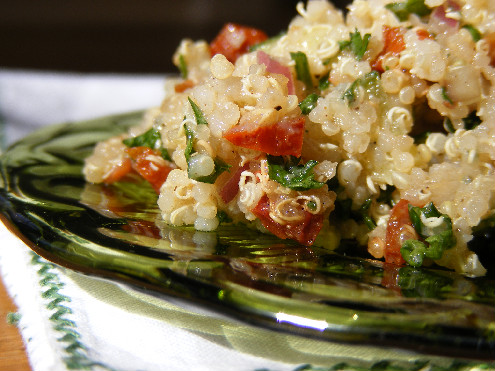Parsley: Sun-dried Tomato Quinoa Tabbouleh
Thursday, June 24th, 2010Parsley is one of my favorite herbs.
Growing up, however, the only time I remember parsley on my plate was as a green garnish that I pushed to the side. Then, years ago when I began eating Middle Eastern foods like tabbouleh, the herb found a regular place in my heart and garden.
I grow both curly and flat parsley and prefer the curly version for tabbouleh.
Parsley’s exact origin is uncertain but is believed to have been in the Mediterranean region, from Spain to Greece and its use has spread throughout the world for both culinary and medicinal uses.
There is also much folk lore surrounding its use – one particular belief was that the herb would only flourish in gardens where a strong woman presides over the household. Snap!
The herb is a key ingredient in several cultures including those from the Middle East and North Africa. It’s essential in the refreshing salad tabbouleh (also spelled tabouleh, tabbouli, tabboule) that has its roots in Lebanon and Syria.
Traditionally the dish has parsley, mint, tomatoes, bulgar wheat, lemon juice, olive oil and seasonings such as allspice and cinnamon. It’s often eaten by scooping it up in lettuce leaves. In the Middle East, it is more of a green salad than a grain salad.
Over the last several decades the salad has grown in global appeal, which has led to a variety of interpretations – such as in North Africa where the cracked wheat is substituted with couscous – and, here in my Colorado kitchen, where this recipe uses quinoa. When I don’t have garden fresh tomatoes, as in now, I use sun-dried. My tomato plants are growing at a snails pace, or so it seems. I created this recipe for a local magazine spread and for those eating gluten free.
Tabbouleh makes a great snack, side dish or a complete meal with hummus or falafel.
Tidbits on Parsley:
- There are three common varieties of parsley: curly, flat (Italian) and Hamburg. Parsley is rich in vitamin C and iron.
- Parsley is related to carrots, parsnips, and celery.
- Parsley has an honored place in folk lore and history: parsley was used in Greek and Roman ceremonies; it was sprinkled on corpses to abate stench, Greek athletes were crowned with parsley and during the Middle Ages it was credited with lethal powers – pulling parsley root from the earth while calling out an adversary’s name could cause death. It was also believed to promote menstruation, facilitate childbirth, and increase female libido.
Sources: “Parsley,” The Gale Encyclopedia of Alternative Medicine, Ed. Laurie J. Fundukian; Encyclopedia of Spices at theepicentre.com; the Encyclopedia of Food and Culture






